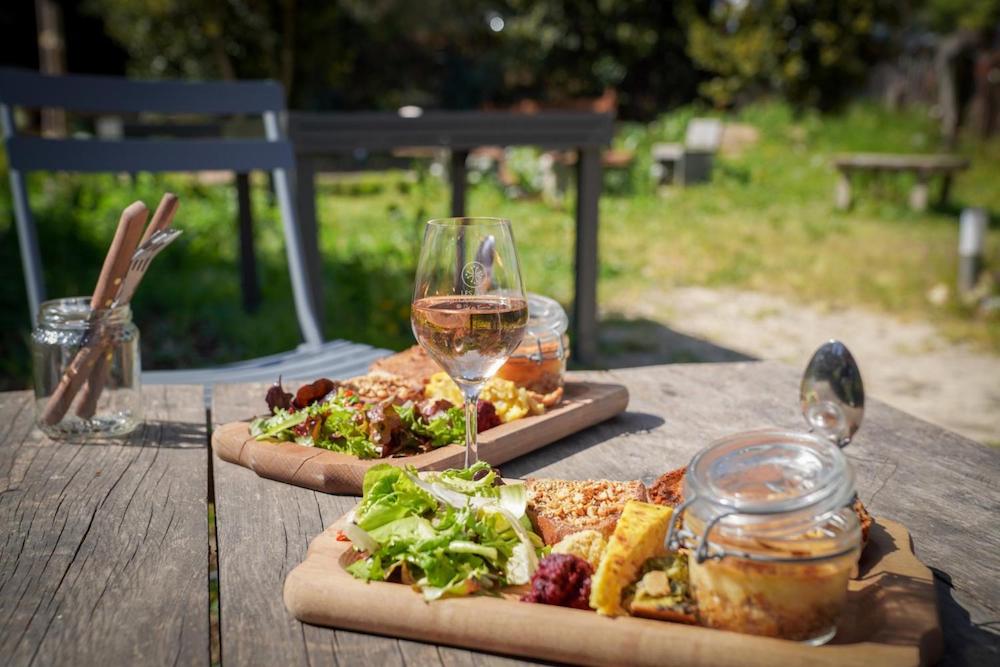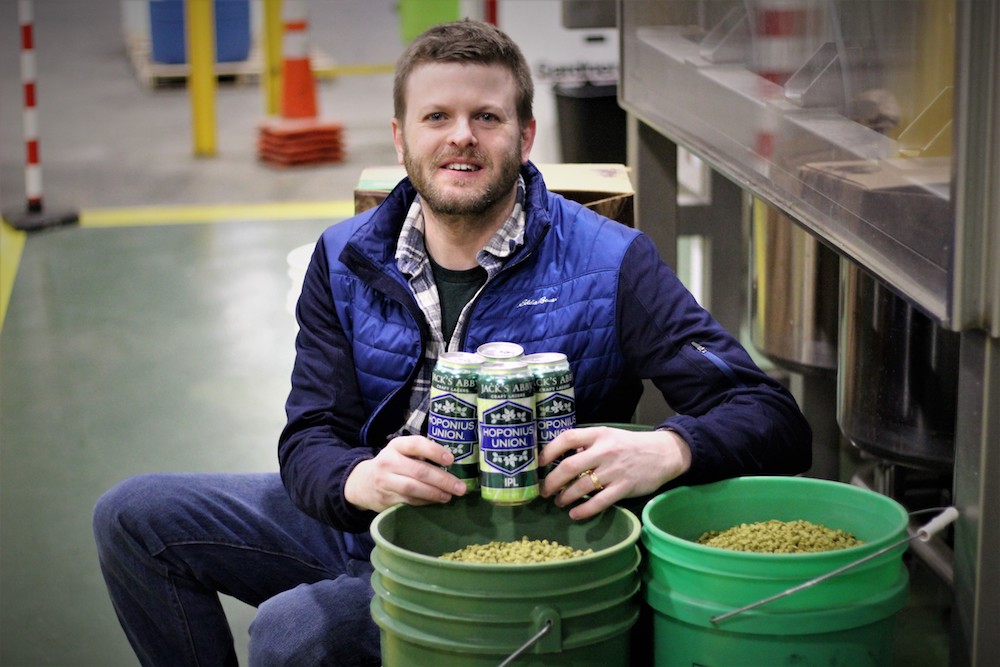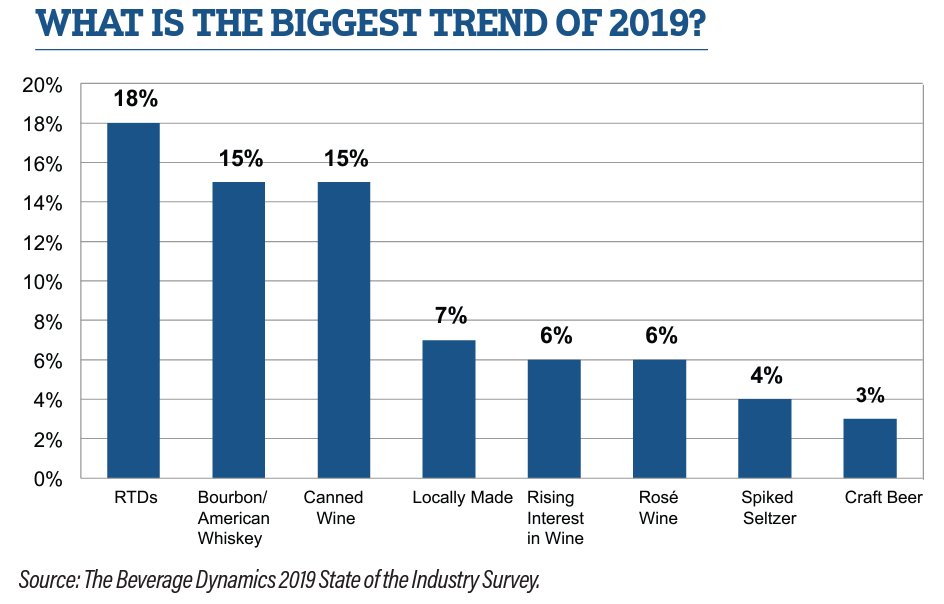Consumer tastes never settle. They gradually change in subtle shifts and evolutions. And they can vary greatly from state to state, and across the country. That’s why Beverage Dynamics polls its readers each year on current trends.
Results from our 2019 State of the Industry Survey painted a diverse picture. Answers differed greatly, representing a broad swath of what U.S. consumers want. But even among these disparate answers there emerged common observations that pointed towards larger trends in America.
We consider these below, the prominent trends defining alcohol retail in 2019-20.
1) Cans, Cans, Cans
Canned wine is no longer the next thing coming but a popular trend that’s very much here and now. In our 2019 State of the Industry Survey, alternative packaging was the third-highest answer (14%) for the trend most impacting retail businesses, behind only the broader categories of bourbon/American whiskey and wine.
Canned wine was also the fourth-highest response (9%) in what retailers wanted to expand shelf space for, and came in third for the biggest trend of 2019 (15%).
The can movement is also at the core of the Ready-to-Drink explosion (more on that later), and has swept through craft beer, where the 4-pack of tallboy cans has replaced the 750-ml. “bomber” as the go-to premium packaging. The craft beer explosion has also made Millennials used to drinking premium products from cans, preparing them for the alternative-packaging trend in wine.
Cans are lighter and more mobile than glass counterparts, easier to transport on hikes and other outdoor activities. And they can go places that glass cannot, like pools, parks and beaches. Which all points to continued growth ahead for cans, especially in wine.
“We’re still just at the tip of the spear with alternative packaging,” says Scott Moore, SVP national accounts off premise at Southern Glazer’s Wine & Spirits. “The Millennial experience in wanting things now, with instant gratification, fits perfectly with these different forms of packaging.”

2) Brown Spirits Continue Booming
There is no slowdown in sight for bourbon and American whiskey. Much the opposite: new craft distilleries open up every day, while global corporations like Diageo, Brown-Forman, Constellation Brands and Pernod Ricard have all recently invested significantly in acquiring brown-spirits brands and/or expanding out existing distilleries. The Sazerac Company, as well, is amidst a $1.2-billion infrastructure investment in Buffalo Trace. So it’s no surprise that bourbon and American whiskey were among the most dominant answers in our 2019 State of the Industry Survey.
The straight American whiskey category grew 5.3% in 2018, according to the Beverage Information and Insights Group, reaching 23.29 million 9-liter cases in the U.S. We see no reason for brown spirits to ebb anytime soon. They are in a new Golden Era.
“I’m really excited about where we’re at and where we’re going,” says Sean Yelle, category director for brown/dark spirits at Campari Group, which owns Wild Turkey. “There’s an alignment with consumer demand and what we want to put out there. The industry and consumers are lining up in a way that will lead to better drinks while making the whiskey industry a great place to be right now.”

3) Rosé All Day (and Night) and Year
Much like brown spirits, rosé wine is enjoying historically strong sales. In the past 12 months, the rosé category has grown about 48% in the U.S., according to Moore from SGWS, while wine overall is up only 3%.
The category has transcended its Provence roots to become a style commonly made worldwide. Consumers have never had more rosé options. But is that a good thing?
“Everybody who grows grapes and wants to make wine now makes a rosé,” states Michael Skurnik, founder of Skurnik Wines, during a panel at Vinexpo NYC 2019. “It’s a cash cow because you can make it in three weeks. That’s resulted in an overcrowded category, which has created a lack of clarity for consumers. What are the good rosés? What are the ones of real authenticity?”
Skurnik suggests that the category could benefit from pruning, and foresees the free market doing just that. “In the next five years it’s going to weed out a lot of rosés.”
His fellow panelists did not necessarily agree.

“With the expansion of rosé’s geographies, styles and pricing points, I think it has a lot of runway still in front of it,” says Helen Mackey, VP of enterprise beverage strategy & innovation for Darden Restaurants.
Concurring with her is Patrick Mata, cofounder and CEO of Olé & Obrigado. “Millennials love rosé because it’s not complicated and it’s fun and is accessible with quality. Millennials love to discover, and that’s why I think rosé will grow with different varietals.”
Rosé continues to expand as a food-pairing option, as vineyards “develop gastronomical regional roses that pair well with a sophisticated cuisine,” says Miren de Lorgeril, president of Languedoc Wines, which promotes the Languedoc wine region, producer of 34% of all French rosés and 11% of the world’s production. Also beneficial for the future of the category, she adds, would be “cultivating rosés with complex winemaking and careful production techniques to obtain wines with good aging potential.”
While rosé has become hip to Millennials, de Lorgeril reminds retailers that “there is also an increase in the consumption of rosé by all consumers in general. Consumers between the ages of 40 and 77 are also starting to drink rosé.”
4) Craft Beer Slowdown
Craft beer still sells well. A significant amount (13%) of respondents to our annual retailers poll said that the craft beer trend most impacts their business, while 18% reported their customers most talking about craft beer. Yet there are signs of potential problems ahead.
After years of posting double-digit growth, the category has slowed to increases around 4-5% in the last several years, according to the Brewers Association. Though it’s important to remember that even those single-digit gains continue to outpace the overall beer market, which has been flat or down 1-2%.
What’s going on with microbrews? Part of the problem is that consumers today tend to drink better, but less. And when they do drink, they’re less category-loyal than ever. Whiskey, in particular, has lured away many craft-beer drinkers into spending elsewhere.
And there’s the issue of microbrewery saturation. “The number one trend I see is that there will continue to be too many choices,” says Jack Hendler, co-owner and brewer at Jack’s Abby in Framingham, Mass. “Consumers are more confused than ever with the amount of options — some that are over-the-top — that eventually people will go back to what they know.”

Which is to suggest that the way back to greater growth for craft beer may be eschewing crazier styles for brews more drinkable and approachable. After all, part of the appeal behind the New England IPA/hazy craze that has swept across the country is that these juice-forward products are smoother and less bitter than typical beers, broadening their appeal. (Whether beer that doesn’t necessarily taste like beer is a good thing is an argument for another day.)
Mike Stevens, co-founder of Founders Brewery in Grand Rapid, MI., believes that craft should take a page out of domestic beer and focus more on key brands.
“You look at the beer industry as a whole, we’re all fighting over that same 15% market share, and not that 85%,” he says. To achieve broader appeal among mainstream consumers, “We need to focus on a narrowing handful of brands, not 28 brands, and spending money supporting those core brands,” Stevens says. “We need to free this thing up a bit so that the momentum can get back to the positive numbers.”
5) Premiumization of Everything
The economy has improved. Unemployment is down. Many U.S. consumers (Millennials in particular) who were hurt by the Great Recession in the past decade have put that economically tight time in the rear-view mirror. Not that people are spending excessively, or recklessly, but their personal budgets now include more discretionary income.

“It’s an affordable luxury,” says Moore from SGWS of the premiumization rise. In the past 12 months, spirits priced $25 and up have increased in sales by 13.2%, he says. This includes whiskey, vodka and tequila. “People want to treat themselves,” Moore adds. “People are not going to buy a new car every time they do something good at work, but they will have that premium cocktail that they deserve.”
Or they’ll pick up that top-shelf bottle of bourbon they’ve been eyeing. The nice thing about splurging on premium spirits is that these items (likely) will last some time, and provide the purchaser with numerous enjoyable experiences for their initial investment.
The premiumization trend is more than sipping spirits. “We have premium sodas and mixers and more, all because people are becoming more sophisticated with their tastes,” says Moore.
Agreeing with him is David Jackson, SVP trade relations, COO for the National Alcohol Beverage Control Association. “Premiumization, I think, goes back into the current cocktail culture,” Jackson says. “Pre-Recession, there wasn’t anywhere near this level of cocktail culture. Now even dive bars are doing things with premium bourbons. Having a well-made, handcrafted cocktail is definitely where things have been going for the past few years.”
6) Tequila on the Rise
The tequila category was up 7.9% in 2018 in the U.S., according to the Beverage Information and Insights Group, totaling 18.64 million 9-liter cases. As already covered in the trend above, much (if not most) of this growth comes from higher-end bottles, as consumers increasingly reach for the top shelf.
“With tequila, many people have gotten over just drinking the white tequilas,” observes Moore of SGWS. “They’re increasingly drinking reposados and añejos, and now mezcal as well.”
With the improving economy, consumers have become more adventuresome in their purchases. And premium tequilas fit perfectly into the trend of more people looking for “affordable luxury,” says Moore.

7) RTDs
Ready-to-drink beverages (RTDs) are no longer the cheap, sugary stuff rele-gated to lower shelves. The craft movement has made major headway in this category, going as far as to turn around decades-old stigmas about RTDs being low quality.
Much the opposite is true now. A huge wave of high-quality RTD cocktails has helped this category grow double digits, year over year, in recent time. As with the canned wine craze, drivers here include convenience and quality.
“People today, particularly Millennials, are looking for innovation and quality,” explains Bob Safford, founder of Joia Spirit, which is owned by Prestige Beverage Group. The brand lineup currently includes a Sparkling Cosmopolitan, Sparkling Greyhound and Sparkling Moscow Mule cocktail. “The difference we’re bringing is the next evolution of the craft spirit. We’re taking that trend and putting it into today’s ‘convenient lifestyle’.”
Many of the retailers we polled in our 2019 State of the Industry Survey mentioned RTDs as a dominant trend at their store, or as a subject that their customers come in talking about. Especially around this time of year, when warmer weather means outdoor gatherings and activities, the convenience and variety of canned, premium cocktails fits perfectly into the modern consumer lifestyle.
The result has been an explosion in RTD sales.
“I’ve been in the business a long, long time, but have never seen anything quite like this,” says Wes Lewis, CEO of Ennoble Beverages, which is behind the malt-based canned Bloody Mary RTD called Tipsy Tomato. “We’re so inundated by consumers today looking for something new.”
8) Private Label Products
Producing and retailing your own private label products has become another manner in which stores can differentiate. “It’s a way to have something that only you can carry,” says Moore of SGWS. “Also, it enforces loyalty while being a margins enhancement.”

However, he warns that retailers should not overdo it with these products. Shelves should still have plenty of room for the normal brands that drive people to those categories in the first place, Moore says. “Make sure the consumer still gets what they come in for.”
Another issue with private label products is that they have become the bread and butter of Big Box chains like Total Wine. These superstores rely on sales of their private labels as significant revenue drivers, and thus direct consumers towards these cheaper options.
One way that a smaller retailer can combat these Big Box private labels? Carry them yourself, says Paul Kaspszak, executive director of the Minnesota Municipal Beverage Association. During a panel on the subject during the 2019 Beverage Alcohol Retailers Conference, Kaspszak pointed out that in some states, legally, Big Box stores must make their private labels available to other retailers. So a Minnesota store began carrying these products so that customers bought it from them, instead of at the Big Box.
9) Single-Barrel Store Picks
Similarly, offering store-specific, single-barrel picks has increasingly become a point of differentiation for beverage alcohol retailers.
On a basic level, store-picked bottlings from distilleries like Maker’s Mark or Knob Creak can help put more high-quality product on the shelves. Consumer demand for brown spirits has outstripped supply. Many American brands, especially bourbon, fly out of stores faster than they can come in. Allocations being what they are, it’s difficult to stock even brands like Blanton’s, which were readily available only several years back, forget the likes of Weller and other red-hot whiskeys. So a store pick can help replenish high-end whiskey stock.
Store picks also help establish your business as a destination. If consumers know that you and your staff pick out great barrels during distillery trips, then customers will keep coming back for these specials, while thinking of your employees as go-to whiskey experts. But this can go both ways. A bad bottle can generate a poor reputation, while becoming a “shelf turd” that never sells.
Which is why it’s important to monitor local Facebook and other social media groups of whiskey enthusiasts, says Brad Williams, VP of purchasing and product development for Liquor Barn in Kentucky. These people will post blunt reviews online of your barrel picks, which can help you determine real quality, and what the local market prefers.
Williams is a veteran of barrel picks, having been on many through the years, and spoke on the subject during a panel at the 2019 Beverage Alcohol Retailers Conference. He urges the importance of determining and maintaining a certain store identity when selecting, even if that style does not necessarily match your own preference. While Williams personally likes bold spicy whiskeys, for Liquor Barn he still picks bold, flavorful whiskeys, but tries to skew towards whiskeys that are a little more balanced and complex, creating a store-specific style with broad appeal.

10) Low-ABV, ‘Healthy’ Alcohol
Consumers today care more about what goes into their bodies. This well-established trend has already penetrated alcohol through lighter wines, sparkling seltzers and low-cal cocktails. Now it has expanded with more health-conscious beverages.
For instance: FitVine. Sponsored by CrossFit, this growing brand of wines contains less sugar, carbs and calories. Yet they still boast enough flavor to please a calorie-counting vino-lover.
Craft beer has also become more conscious of its dietary drawbacks. New Belgium’s new beer Mural, a 4%-ABV Mexican-style ale, has only 110 calories, and 0 grams of sugar. Earlier this year Harpoon released a 3.8% hazy pale ale called Rec. League, with 120 calories per pint. And Lagunitas recently launched DayTime IPA: 4% ABV, 98 calories. These brands are targeting active-lifestyle consumers who prefer their beers more flavorful than the traditional low-cal go-to, Michelob Ultra.
And what does it say about this trend that Michelob Ultra — the one macro light lager with year-over-year growth in recent time — has achieved its unusual success largely through savvy marketing aimed at active-lifestyle consumers? Many people now prefer “healthier” options.

11) No Stopping Tito’s
Nearly every craft brand that comes out now dreams of being Tito’s. Perhaps they lose track of Tito’s being an overnight success 20+ years in the making. Regardless, there’s no slowing down this freight train of a one-product brand. Tito’s grew a staggering 21.4% in 2018, according to the Beverage Information Group, reaching 7.34 million 9-liter cases in the U.S. Not bad for a brand that sold 1.2 million cases in 2013.
Tito’s is now the second-best selling vodka in America, behind only Smirnoff, which shrunk 0.8% in 2018 to 9.18 million cases. It’s likely only a matter of time before this Texas brand takes over that top spot.
Kyle Swartz is editor of Beverage Dynamics magazine. Reach him at kswartz@epgmediallc.com or on Twitter @kswartzz or Instagram @cheers_magazine. Read his recent piece, Meet Kaveh Zamanian, Founder of Rabbit Hole Distillery.









